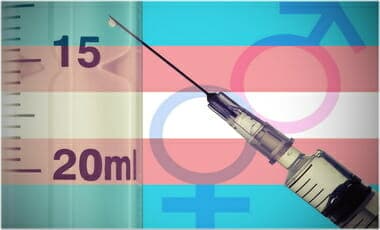
Gay Patriot highlighted an excellent article at the Federalist entitled, “How The Trans-Agenda Seeks To Redefine Everyone,” in which VtheK notes the following:
- This gender-neutral scheme obliterates the template for the family as a unit. And if the family is no longer accepted as a union that originates through the union of male and female, there is no real basis for the State to recognize any family as an autonomous unit. Without any such obligation, children become more easily classified as state property and our personal relationships are more easily controlled by the state. If that sounds totalitarian, that’s because it is.
- The legal erasure of gender distinctions, especially as they relate to the conception, gestation, and birth of children, would effectively cut us off from our spouses and children in the eyes of the law. How can it be otherwise? Yeah, maybe in the bargain we’ll retain the right to “freely” call ourselves male, female, or other. But once we’ve in essence sold our birthright, this is nothing more than a bowl of pottage.
Here is an excerpt from a highly recommended book… the author is also in a video via Blazing Cat Fur added below:
This last example has all the elements: misdiagnosis, suicide attempts and early childhood experiences that twisted this poor boy’s perception of his gender identity into a knot.
The young boy was normal from all accounts until some events begin to alter and reshape his view of who he was. Sometimes when Grandma babysat him alone, she would dress him in female clothing that she made especially for him. His uncle, a troubled teenager, had a favorite sport: making fun of the little boy and yanking down his pants. The uncle turned more aggressive and fondled the boy far too many times over several years, especially while intoxicated.
The young boy started to fantasize about becoming a girl. After years of obsessing, along came Christine Jorgensen in 1955 and the first media reports of a gender change. Then the young boy started to think it was true and he, too, could change genders. The boy in his silence adopted a female name, Cristal West, but only he would know this name and the battleground that was inside him: this silent struggle lasted for years.
Trying to battle against the female trapped inside his body, the boy excelled at all that was male: football, track. cars and yes, girls. All looked normal from the outside, but inside there was pain and confusion about his gender.
As a young teen. the boy attended Eagle Rock Episcopal Church on Chickasaw Avenue. In his teens. the boy sought guidance for his struggle with the internal female from the pastor, Father Carol Barber. At their second meeting, to his shock, Father Barber moved out from behind his desk, unzipped his long black robe to reveal his naked body, and tempted the boy to have homosexual sex. The boy. appalled by the overture, quickly departed and never met with Father Barber again.
In his early twenties, the young man got married, had children and developed skills for high achievement in the business world, first as an aerospace associate design engineer, then by his forties, achieving a national operations position for a major corporation. But his internal struggle with his gender identity never went away and he used alcohol to numb the pain. Alcohol became the pathway to drugs which would bring, his impressive career to an abrupt and tragic end.
In his forties, his marriage failed. His two teenage children suffered a great betrayal when their father turned to hormone therapy in San Francisco. A skinny old doctor named Garfield who asked no questions and took no names provided the hormone injections. Over the course of time, Dr. Paul Walker approved him for surgery and Dr. Biber performed the surgical gender change.
In 1983, the man became Laura with a new birth record that specified gender as female. She had success after a few years —good looks and good jobs, recovery from drugs and alcohol—but living as a female just did not resolve the internal struggles. It was during the time Laura was studying to be a counselor at U.C. Santa Cruz in the late 1980s that she came to understand that as a transgender, she was living a self-imposed exile from her true identity.
As Laura’s intellect and thought processing ability reemerged from the alcohol- and drug-induced fog, a sober Laura could see that being a transgender was not real, but a fantasy forged out of very powerful obsessive thoughts and feelings that took over her life. As a young boy, the expression he had used to express his feelings of hurt and pain was “girl trapped in a male body.” Hiding in a transgender persona was her elaborate way to escape the deep hurt. Acting out was very important to Laura in expressing how she felt, but letting feelings define identity is never a good idea. She later commented that transgender life was like living in a temporary zip code not located near reality. She learned that the transgender feelings would be overwhelming at times, but no matter how strong the feelings are, they can never define her real identity.
Laura was determined to recover on every level, including her male birth gender. She learned in her counseling studies that recovery requires an unwavering persistence with good people supporting her. Recovery was a bit rocky and the path twisted and difficult, but now with 25 years in the rear view mirror, he is restored and has been married to a wonderful lady for 14 years. He made it back.
I know this story all too well, because that was me, the little kid from Glendale. Most of my life I thought I had been born in the wrong body but my traumatic experiences occurred after birth, not in the womb. Regrettably, I learned to dislike the boy who was fondled by an uncle, cross-dressed by a grandmother and propositioned by a homosexual clergyman. I was never a homosexual or felt the desire for men. My rejection of my birth gender was the result of abuse I suffered from several adults.
I learned after surgery that my primary issue was called dissociative identity disorder, which in turn either caused the gender disorder or displayed symptoms that looked like it. The treatment was strenuous psychotherapy to address the primary disorder, not undergoing irreversible surgery to treat a symptom. Comorbidity, the presence of more than one disorder in an individual, is common in transgenders.
So, what made me so different from other transgenders? That is simple—I wanted to recover. Like any recovery, it started with the desire to recover. Without desire, no change is even possible. I did not want to live my life in a masquerade, but in truth. I discovered there was no real medical necessity for the surgery. It was a lie.
Even the doctors who were advocating for me to change genders did not have a clue what it was all about. Psychologist Paul Walker said adaptability is the key to success in changing genders. Surgeon Stanley Biber said success is defined by the ability to physically engage in sex. Psychologist John Money at Johns Hopkins said hormones make the new gender work. Not one, however, said surgery was medical necessary, so it must not be. Dr. Paul McHugh reflects views that more closely align with my personal experience when he said, “It’s a disaster.” Sadly, a gender wreck is not one you bounce back from easily.
In my view the history of psychosurgery demonstrates a lack of accountability and oversight in the medical community that continues today. Activist lawyers and doctors join together to lobby for, and effectively get, more and more laws passed that provide even more protection for reckless, medically unnecessary surgeries. The evidence suggests a need exists for a broader base of nonsurgical therapies, such as psychological interventions, in an effort to improve care.
Now the children have caught the eye of the activist surgeons. Soon young kids will go under the knife and we’ll see television shows like “Twelve Year Old Transgenders in Tiaras.” Who should hold accountable the doctors who are playing with children’s hormones? A 2007 Dutch study says, “Fifty-two percent of the children diagnosed with GID [gender identity disorder] had one or more diagnoses other than GID…Clinicians working with children with GID should be aware of the risk for co-occurring psychiatric problems.'” Treating GID with irreversible surgery, while ignoring co-existing conditions, is a recipe for patient regret and suicide.
Transgenders want more freedom when perhaps they actually need more boundaries. The real life-threatening harm to transgenders is not a consequence of bullying; it results from the transgenders’ own high-risk sexual behaviors, illicit drug use, and alcohol abuse. Transgenders have been shown to be prone to harming themselves. Unfortunately, the activist agenda is directed toward more laws to protect transgenders instead of finding better treatments to reduce the number of suicides and regretters.
The evidence is clear—the surgery is not medically necessary and many problems occur as a result of changing genders. The personal testimonies are further confirmation that changing genders can result in very painful regret. In the next chapter we conclude with an explanation of how effective treatment got derailed by the activists and we explore some possible solutions for reducing the number of transgender regretters and deaths by suicide.
Walt Heyer, Paper Genders: Puling the Mask Off the Transgender Phenomenon (Make Waves Publishing, 2011), 87-91.








